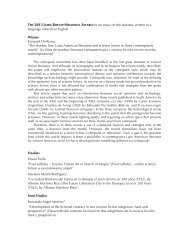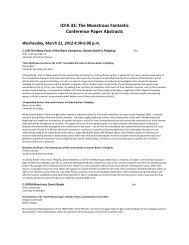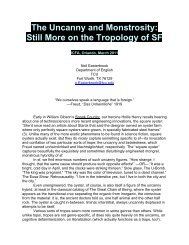91. (SF) Animal Studies, Plant Studies, and Ecological Ethics OakChair: Brian McAllisterAlbany State University<strong>The</strong> Dragon or the Egg: Hard SF, Ecological Ethics, and Thing PowerSha LaBareUC Santa CruzThinking ecologically is perhaps the most important skill of our times. As Timothy Morton argues, ecological readings need not focus on textswith blatant natural and environmentalist themes; like feminist, queer, and race critical approaches, ecological theory is also relevant forthinking about texts with no obvious environmentalist content. As with these other approaches, a radical ecological way of reading may openup thinking that was hitherto unimaginable, thinking with monstrous and transformative potential. With this in mind, "<strong>The</strong> Dragon or the Egg"draws on one classic hard sf novel - Robert L. Forward's Dragon's Egg (1980) - to show how technoscientific worlding might generate alternateecologies. "<strong>The</strong> Dragon or the Egg" uses insights from an alternate reading of Dragon's Egg to explore what Jane Bennett calls "thing power", adepersonification project that reverses many Enlightenment values and opens the way for ecological thinking beyond its current incarnations.In the process, I will also further my argument that ecology is not only vital to sf, but also and more importantly that sf is vital to ecologicalthinking.Lives of the Monster Plants: <strong>The</strong> Revenge of the Vegetable in the Age of Animal StudiesTimothy S. MillerUniversity of Notre Dame<strong>The</strong> strain of posthumanist thought known as critical animal studies, human-animal studies, or simply animal studies has done much to advanceour thinking about the place of animals not only in literature but also in their real embodied existence alongside our own. Yet the specter of themonster plant, lurking so often on the fringes of science fictional narratives, may itself challenge some of the unexamined assumptions of acritical formation like animal studies, just as surely as animal studies has effectively challenged the "speciesism" inherent in other criticalformations. While this paper does not advocate for the development of a "plant studies," and acknowledges that some forms of deep ecologyand ecocriticism position plant life as deserving of equal respect, it will invite further thinking about the implications of taking the word"species" in animal studies more literally, as the word so often seems to mean "mammal species" or "animal species": what happens when wethink about the implications of plant lives, so often figured in fiction as monstrous lives? Does the monster plant speak to an unease about theboundary between kingdoms that even recent work done in animal studies can have difficulty navigating? Indeed, Jeffrey Jerome Cohen,influenced by the speculative turn in critical theory, has recently undertaken a major project examining the "life" of stone, yet even Cohen, inreaching for, as he puts it, what seems "as inhuman a substance as can be found" (58), proceeds directly from animal to mineral and skips thevegetable. Plants, it seems, often get overlooked, walked over -- and we must recognize that our daily trampling of the plant persists on boththe literal and metaphorical levels. Accordingly, this paper will survey a few of the many monstrous plant narratives in speculative fiction inorder to demonstrate how monster plants speak to anxieties as well as potential areas of cross-being communication located on the boundarybetween the animal and vegetable, for science fiction offers us not only the infamous triffids of post-apocalyptic nightmare, but also moremisunderstood monstrous plants like the "ultraphytes" of Joan Slonczewski's recent novel <strong>The</strong> Highest Frontier.Packs, Singletons, and Animality in "A Fire Upon <strong>The</strong> Deep" (or 4 Legs Good, 20 Legs Better)Bruce LordTrent UniversityUsing several of the perspectives yielded by recent work on animal studies and science fiction as well as Deleuze and Guattari's concept of“becoming animal”, I will explore how Vernor Vinge's "A Fire Upon <strong>The</strong> Deep" examines and critiques standards of personhood and animality.Specifically, I will discuss the novel's negotiation of these categories through interactions between humans and the alien (and simultaneouslyanimal) Tines, an intelligent race whose people are made up of “packs” of individual bodies which may enter and exit a Tinish subject over time.I argue that Vinge at once critiques a humanist delineation between person and animal which is distinctly Cartesian, as well as upsets views ofidentity and subjecthood (characterised by Deleuze and Guattari as molar) as being stable and inviolable through the Tines and their discourseon humanity. In the Tines, Vinge not only explores how Cartesian rhetoric on personhood might sound from theopposite side of the species divide, but also the possibilities offered by the molecular mode of being championed by Deleuze and Guattari.
92. (F) Leaving the Demonized Other Behind MapleChair: Jude WrightUniversity of South FloridaRelativism and Fantasy: Ambiguous Morality in Erikson’s Gardens of the MoonAdrian BackmannUniversity of OttawaThis paper compares and contrasts Erikson’s narrative to the philosophy of Friedrich Nietzsche found in Beyond Good and Evil and how thatrelates to a greater literary tradition. I show how Erikson’s technique creates a realistic world that has deeply linked emotional value and apowerful artistic commentary on the nature of humanity’s flaws. By foregoing the classic structure of good versus evil, Erikson has set himselfapart from a fantasy community largely devoted to the preservation of cultural values and beliefs. Due in part to Erikson’s history as ananthropologist, as well as to the situations depicted in his novels, he seems to be in accordance with moral relativists such as FriedrichNietzsche who reject short cuts to morality set up by religion and philosophy. Erikson does not employ a dominant moral standpoint to drivethe story forward. Instead, the narrative creates sympathy for a large variety of characters, even from opposing factions. As a result, right andwrong only exist in an individual’s perspective. <strong>The</strong>re are no romanticized notions of Good and Evil that transcend the day-to-day lives ofErikson’s characters. Also, since this is a fantasy set in a secondary world, there are no moral reference points for the reader. This moralambiguity forces the reader to decide for themselves what is right and what is wrong, a struggle they share with the characters in the novel.This way, Erikson’s novel participates in Nietzsche’s noble/slave morality as it encourages moral independence. Also, by taking place during awar, Erikson shows the ugliest sides of humanity and shows how even regular people can become murderers. Instead of focusing on ademonized Other, Erikson focuses on the monstrosity of human history. However, Gardens of the Moon goes beyond the violence to use thesame technique of perspective to affect sympathy and understanding rather than condemnation.Morphing Monsters: Orcs as Other in Fantasy FictionHelen YoungUniversity of SydneyOrcs, are the staple humanoid monster of fantasy fiction. <strong>The</strong> word ‘orc’ was used to denote goblin-like creatures as far back as the 1600s butin the modern era, and in fantasy fiction in particular, orcs owe their existence to the imagination of J. R. R. Tolkien. If Tolkien had the first wordon them, however, his was not the last. This paper investigates the development of the orc as monstrous Other and the ways that conventionsare used, reused, and adapted to explore issues of race and difference. How do images of monster and human, evil and good shift as the genredevelops in response to wider social and cultural changes around ethnicity, race, difference and diversity? <strong>The</strong> paper begins with a briefconsideration of some of the sources for Tolkien’s orc to illuminate the origin of the genre’s conventions and demonstrate their inextricable linkto the often monstrous Saracens in the western literature of the Middle Ages. It will then consider works which engage with those conventionsdirectly, including Stan Nicholls’ Orcs trilogy, and Terry Pratchett’s Unseen Academicals. <strong>The</strong> paper argues that orcs have represented a useful,but often problematic Other. Tolkien himself was troubled by his own creation: were they corrupted humanity? Could they ever be anythingother than ‘evil’? Where had they come from and what ought their fate be in a world of triumphant ‘good’? <strong>The</strong>se types of questions are takenup in the later texts this paper explores; I argue that orcs are, in some cases at least, becoming less monstrous and more human.“Let’s hunt some Orc!”: Re-evaluating the Monstrosity of OrcsA. P. CanavanEdgehill UniversityWith the exception of Dragons, one of the most recognisable ‘monsters’ of genre fantasy is the humble Orc. Orcs, commonly found in hordes,are the disposable foot soldiers of every evil wizard’s army, and are useful opponents/victims for would-be heroes-in-training. <strong>The</strong>y are evil,barbaric, ugly, brutal and, above all, monstrous. But given the trend of modern Genre Fantasy to move away from simplistic moral polarities tomore complicated moral relativistic positions, can we still treat and react to Orcs in the same way? With some notable exceptions, MaryGentle’s Grunts (1992) and Stan Nicholls’ Orcs (1999-present), the treatment of Orcs has remained fairly consistent ever since Tolkienpopularised them as the enemies of the hero. Using established critical techniques already associated with the fantastic, in particular themonstrous other, otherness, and the psychological readings of monstrosity, the position of the Orc will be established in the context of thegenre. <strong>The</strong>n, by examining how the Orc has been used in related fantasy media, such as the RPG, it will be shown how the function of the Orchas changed into a ‘disposable’ monster. Lastly, with the Orc as a cypher for almost every evil sentient monster deployed in Genre Fantasy, thispaper will examine how we ‘read’ Orcs and suggest that the true monstrosity is the reader’s casual acceptance of racial genocide rather thanthe Orc’s position as <strong>Monstrous</strong> Other.
- Page 4 and 5: 5. (F) Wondrous Bodies of the Gende
- Page 6 and 7: Fantastic Suicide: Reading the Unca
- Page 8: Viral Posthumanism: Boundaries and
- Page 11 and 12: The Concept of Soul Divisibility in
- Page 13 and 14: Thursday, March 22, 2012 10:30 a.m.
- Page 15 and 16: 21. (CYA) Terrifying Futures: Post-
- Page 17 and 18: 23. (FTV/H) Now I’m Feelin’ Zom
- Page 19 and 20: Fight Club: Amalgam of the Horrific
- Page 21 and 22: Taking the Monsters out of the Clos
- Page 23 and 24: Kaspar J. SaxenaIndependent Scholar
- Page 25 and 26: 44. (CYA) The Monstrosity of Teenag
- Page 27 and 28: 46. (FTV/SF) Monstrous Spin-offs: T
- Page 29 and 30: 49. (F) Aspects of Miéville Captiv
- Page 31 and 32: 53. (SF) War and Crisis in 1940s an
- Page 33 and 34: Abuse of Power: An Evolutionary Res
- Page 35 and 36: Disappearing Natives: The Colonized
- Page 37 and 38: 60. (H/IF) Ancient and Medieval Mon
- Page 39 and 40: 62. (F) The Works of Tolkien Captiv
- Page 41 and 42: 67. (SF) Imperial and Postcolonial
- Page 43 and 44: Beheading the Gorgon: Beautifying C
- Page 45 and 46: 71. (VPA) Monstrous Music MagnoliaC
- Page 47 and 48: 73. (F/IF) Portraying New Worlds Ca
- Page 49 and 50: Friday, March 23, 2012 2:45-3:45 pm
- Page 51 and 52: 81. (FTV) Those Damn Dirty Apes! Cy
- Page 53: Friday, March 23, 2012 4:00-5:30 pm
- Page 57 and 58: 94. (FTV/CYA) Monstrosity and Devia
- Page 59 and 60: of cannibalism, ghostly seduction i
- Page 61 and 62: Saturday March 24, 2012 8:30-10:00
- Page 63 and 64: 104. (CYA) Classic Monsters, Reinte
- Page 65 and 66: 107. (VPA) Monstrous Gaming Bodies
- Page 67 and 68: who challenge the order that the Br
- Page 69 and 70: Reading Between the Times: A Critic
- Page 71 and 72: 117. (FTV) Monsters and Superheroes
- Page 73 and 74: 119. (IF/H/PCS) International Mash-
- Page 75 and 76: Focusing on Stoker's Dracula as one
- Page 77 and 78: Florida Atlantic UniversitySheri S.
- Page 79 and 80: Simmons CollegeIn the spate of rece
- Page 81 and 82: Independent ScholarKing’s story
- Page 83 and 84: modernity opens up for every indivi
- Page 85 and 86: Saturday March 24, 2012 4:00-5:30 p
- Page 87 and 88: 141. (FTV) Monstrous Masculinity Cy
- Page 89 and 90: ultimately make peace with her mons
- Page 91 and 92: where the almost-human sentient zom





